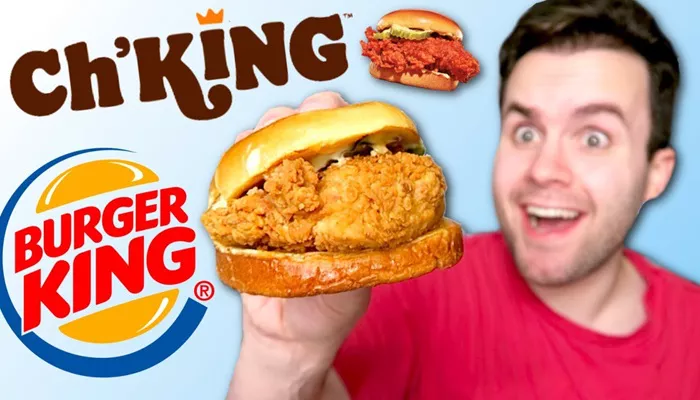Burger King, a global fast-food chain known for its flame-grilled burgers, has made various menu changes over the years to cater to customer preferences. One of its notable attempts was the launch of the CH King. Despite initial excitement, Burger King ultimately decided to stop promoting CH King. This article explores the reasons behind this decision, examining market trends, customer feedback, and internal strategies.
Understanding The CH King
The CH King was introduced as a chicken sandwich aimed at capturing a share of the growing chicken sandwich market.
With a crispy chicken fillet, special sauce, and fresh toppings, it was designed to compete with similar offerings from competitors like Chick-fil-A and Popeyes. The sandwich was part of Burger King’s strategy to diversify its menu and appeal to a broader audience.
1. Market Competition
The Rise of Chicken Sandwiches
In recent years, the fast-food industry has witnessed a surge in the popularity of chicken sandwiches. Chains like Chick-fil-A and Popeyes have dominated this segment, garnering a loyal customer base. The intense competition forced Burger King to rethink its strategy regarding the CH King.
Differentiation Challenges
Burger King struggled to differentiate the CH King from its competitors. While the sandwich was well-crafted, it did not stand out enough to capture significant market share. Customers often saw it as just another option in a crowded field, leading to lukewarm sales. In a saturated market, unique selling points are critical for success, and the CH King lacked this advantage.
2. Customer Feedback
Mixed Reviews
When the CH King was launched, initial customer feedback was mixed. While some enjoyed the flavor and texture, others felt it didn’t live up to the expectations set by competitors. Social media platforms were filled with reviews that highlighted the sandwich’s average quality, which contributed to its decline in popularity.
Taste and Quality Concerns
Many customers pointed out that the CH King did not deliver the same level of taste and quality as other chicken sandwiches. Some reviews indicated that the chicken was not as crispy or flavorful as they had hoped. In a market where taste is paramount, negative feedback can significantly impact sales.
3. Marketing And Promotion Issues
Ineffective Marketing Campaigns
The marketing strategy surrounding the CH King also played a role in its lack of success. The promotional campaigns did not resonate with the target audience, failing to generate buzz or excitement. Effective marketing is crucial for product launches, and in this case, Burger King’s efforts fell short.
SEE ALSO: How Much Is Burger King Crispy Chicken Sandwich?
Timing of Launch
The timing of the CH King’s launch was also problematic. It coincided with numerous other fast-food promotions, diluting its visibility. In a fast-paced industry, timing can be everything; the CH King needed to be launched when customer interest in chicken sandwiches was at its peak.
4. Internal Strategy Reevaluation
Focus on Core Menu Items
Burger King decided to focus more on its core offerings, such as the Whopper, rather than expanding into crowded categories. This strategic pivot allowed the company to concentrate on items that had historically driven sales and maintained brand identity. By scaling back on the CH King, Burger King could reallocate resources to strengthen its primary menu.
Resource Allocation
The decision to stop promoting the CH King was also influenced by resource allocation. Maintaining a sandwich that was not performing well required marketing budgets, staffing, and supply chain management. By discontinuing the CH King, Burger King could better allocate these resources to products with higher sales potential.
5. Financial Considerations
Sales Performance
Sales performance data indicated that the CH King was underperforming compared to other items on the menu. Financial analysis showed that continuing to invest in a failing product was not sustainable. Businesses must prioritize items that generate revenue, and the CH King did not meet those expectations.
Cost-Benefit Analysis
A thorough cost-benefit analysis revealed that the expenses associated with the CH King outweighed its benefits. Factors such as ingredient costs, marketing expenditures, and operational logistics contributed to the decision to cease its promotion.
6. Consumer Trends
Shift in Preferences
Consumer preferences have shifted towards healthier options, and Burger King needed to adapt to these changes. The CH King, while not unhealthy, did not align with the current trends toward fresh, nutritious meals. As more customers seek healthier fast-food options, products must evolve to meet these demands.
Demand for Plant-Based Alternatives
Another significant trend in the fast-food industry is the growing demand for plant-based alternatives. Many consumers are seeking vegetarian or vegan options, and traditional chicken sandwiches may not meet their needs. Burger King has begun focusing on plant-based offerings, such as the Impossible Whopper, to cater to this demographic.
Conclusion
The decision to stop promoting the CH King was influenced by a combination of factors, including market competition, customer feedback, marketing effectiveness, internal strategy, financial considerations, and changing consumer trends. In an industry characterized by rapid shifts, companies like Burger King must continually adapt their offerings to stay relevant.
While the CH King had potential, it ultimately could not compete in a crowded marketplace, leading to its discontinuation.
Related topics:
- How Many Gyu-Kaku Locations Are There in The Us?
- How Does First Watch’s Training Program Support New Franchisees
- The 6 Best Burger King Meal in 2024

